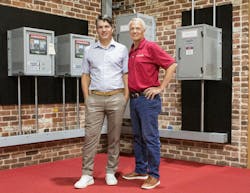2024 IndustryWeek’s Best Plants: At HindlePower, Taking Care of Business Means Taking Care of Your People
Many manufacturers talk a good game about how much they value their employees, how the workforce is the business’s greatest resource. At HindlePower, those words mean more than motivational posters plastered on a wall or a tired phrase. The company literally has cast its commitment to its workforce in bronze.
HindlePower
- Easton, Pennsylvania
- Employees: 102
- Total Square Footage: 110,000
- Primary Product: stationary battery chargers and battery cabinets, tailored for the utility industry
- Start-up Date: 2000
- Achievements: 4 time recipient of the Morning Call's Lehigh Valley top Workplace Award; 100% of production workforce participate in empowered or self-directed work teams; launched new product line in 2019 that now makes up a substantial percentage of revenue, and improved the quality rate even as the new line was introduced
On a grassy spot on an outside corner of its operations in Easton, Pennsylvania, HindlePower recently installed an eye-catching statue that portrays two women and one man, each performing a different task emblematic of modern manufacturing and the diverse tasks that make it go: One is working with her hands; another is on a machine and a third is wielding a robot controller. These aren’t generic models, they’re current and former HindlePower employees.
The work of art is deliberately larger than life “to symbolize the significant impact our workers have on our lives and to honor them with reverence through this artistic expression,” explains HindlePower’s Brian Fritz.
Take care of your people and they will take care of your business. Family-owned HindlePower performs the former with an emphasis on education and personal growth. Its performance data reflects the truth of the latter: a 5% annual labor turnover rate; 97% on-time delivery, a metric it maintained even during the COVID-19 strain on the supply chain; and productivity growth of 23% in the past three years.
These are among the reasons IndustryWeek judges selected this Pennsylvania manufacturer as one of two 2024 IW Best Plants Award winners.
“We like to put people in places of opportunity to see if they can grow, and most of the time they do. Most of the time they take it and they run, and they run really far with it.”
Agility Delivers Gains
HindlePower’s workforce of 102 plays an important role in supporting the electric grid’s infrastructure. The Lehigh Valley manufacturer produces industrial battery chargers and outdoor enclosures designed for the utility industry. It offers extensive customization to its customers, including enclosure styles and voltage variations.
Continuous improvement and problem-solving teams are cornerstones of HindlePower’s drive for manufacturing excellence. For instance, the company’s ideas program encourages individual efforts to make improvements. Safety teams aim to keep injuries at bay. Bigger projects target improving quality, efficiency, or any of the myriad components that make up a manufacturing operation.
These efforts have helped to create an “agile” organization, explains President Nic Hindle. Hindle leads the company, having taken on the leadership reins about three years ago from his father, Bill.
Such agility speaks to how well an organization moves from process to process, Hindle says, "especially if you've got different product makeups or a lot of different variations within your products," as well as the business’s ability to change focus “to make sure that it's always meeting the challenge of today, the month, to the quarter or the year, even larger than that.”
“I believe we are very agile in the way that we can manipulate ourselves in order to meet the challenge,” he says. Cross-training plays a role, “but we also do that a lot through our culture … We all realize this is what we're doing today, but if all of a sudden the organization needs to do something really important tomorrow, either for ourselves or for the customer, more often than not we are all on board to do that.”
One illustration of the manufacturer’s agility came into play several years ago, when HindlePower was gearing up to introduce a new product line (during COVID no less).
“In a matter of about two months, we were able to completely reconfigure our entire plant floor,” says Hindle. “We had buy-in and feedback and planning from over 25 different employees, all contributing towards this, and so we were able to completely reconfigure our plant floor without actually ever shutting down our plant for one day.”
The company’s flat organizational structure promotes such flexible and nimbleness. A lack of management layers “allows us to collaborate incredibly well,” Hindle says. “Anyone in any part of the organization can go talk to somebody else in the organization. They don't need to go through layers of management in order to bring up ideas or project approvals or anything like that.”
It’s a People Thing
Such trust in the process has been built on years of HindlePower pursuing what it describes as its core purpose—"to improve the lives of our employees.” Evidence of that pursuit abounds and includes:
Free lunch: HindlePower offers employees free lunch available four days a week. (A recent menu included pork, potatoes, salad, rolls, a vegetable and fresh fruit.)
Bi-weekly all-hands meetings: “We do it every two weeks because we feel it's important to get everyone together,” Hindle says. Not only does the frequency help create a sense of camaraderie, he says, but “but it's an opportunity for management leadership, myself, to continually update everyone—what's going on in the company, how the company's performing, what our major projects [are], what are we striving for. Everyone's in the know, there's no surprises.”
Equally important, “It's a great opportunity for people on the production floor, engineering, sales, tech service, order entry, purchasing, if they're working on anything, for them to get up and talk about what it is that they've been able to accomplish.”
Training/Education: Education is core to HindlePower and is offered in a variety of ways. Adjacent to the production floor is a quality and training center where new employees can practice on a model production line without the fear or nerves that can accompany going directly to a working manufacturing line. “We wanted to make it safe for people to learn,” explains Carol DiTaranto, who leads the training facility. “We knew we needed to improve in this area, and we didn’t want to fail them by just putting them on the floor.”
The hands-on training augments HindlePower University, which is the manufacturer’s in-house classroom training that addresses a variety of topics. Even more, the manufacturer offers tuition reimbursement and other educational opportunities to foster a skilled workforce.
Sabbatical: Reach 32 years with the company and you get a three-month sabbatical at full pay. Travel outside of the United States, and HindlePower adds another $10,000 to the package. The extra boost is not about urging employees to see more than the United States, explains Hindle. It’s more about removing a hurdle to thinking big. “Some people in manufacturing, you know, they never thought they could take a trip to Spain or France or England or Germany … or whatever it is that they want to go and do. We want them to be able to … whatever they were dreaming of, whatever their bucket list was like, go do it [and] we will help you along this process.”
Gainsharing: A robust gainsharing program gives workers an opportunity to share in a percentage of the company’s profits.
Most telling, perhaps, on the people side, is HindlePower’s all-out effort to put people in a situation in which they can thrive. As part of her position, plant manager Cecelia Ortiz interviews an employee a week “to find their passion” and tries to accommodate them when possible. It’s not always possible, or not always possible immediately, but a workforce “where everyone is happy makes my job easier,” she says.
The company is not immune to people issues, Hindle says. However, “cultivate people’s strengths, manage their weaknesses and give them an opportunity [and] all of a sudden you see them do amazing things,” Hindle says.
One example is Brad Stein, who joined the HindlePower as a temp, worked his way to production lead, then moved into purchasing and now is learning drafting. Another is Brian Fritz, who joined the company in what was supposed to be a six-month stint during COVID in a role he calls “special ops.” It means he worked on a variety of projects (including the bronze statue). Today, Fritz, who had been a paralegal and is now pursuing additional education, largely contributes to human resources, but his position is flexible enough that his business card does not include a title. “My job now; I created it,” he says.
Nineteen-year HindlePower veteran Ortiz may provide the best example of opportunity taken, however. Now plant manager, she started at the manufacturing company as a part-time cleaner.
Ultimately, “We like to put people in places of opportunity to see if they can grow, and most of the time they do,” Hindle says. “Most of the time they take it and they run, and they run really far with it.”
Supplier Relationships
HindlePower’s relationship-building extends beyond an internal focus. Like most manufacturers, HindlePower faced a supply chain crisis during COVID. Strong supplier partnerships, combined with a little agile engineering, prevented the damage from being worse.
“We want to find ways to make our suppliers never want to leave,” explains Steve Bohard, director of supply chain management. (HindlePower’s sheet metal vendor is actually physically located as close as a supplier can get; it shares with the manufacturer a second building located across the parking lot from HindlePower’s primary site.)
What does a strong supplier relationship mean? Among other considerations, it means everything does not come down to price. It starts with quality.
“It also means looking at what’s good for them and what’s good for us and be willing to have those conversations,” Hindle says. “We take those things very seriously, and we really try to make sure that we’re not the type of customer that’s saying, ‘We need this yesterday.’”
Even with such supplier relationships, HindlePower struggled during COVID with access to integrated circuits, which are vital to the company’s products. HindlePower’s electrical engineering team stepped in to redesign or modify main control boards across a host of products to take advantage of components that suppliers were able to provide more readily.
Bohard says the company’s strong supplier relationships were essential to HindlePower’s ability to maintain high on-time deliveries even during the crisis. “By working with them, they’ll do a lot more for you,” Bohard adds.
Learning the Business From the Inside
HindlePower President Nic Hindle didn’t join the family business immediately upon exiting college as a mechanical engineer, and that was by design.
“Very wisely, my father said, ‘You can’t come work for me. You need to go work somewhere else before you come into the family [business],’” explains Hindle.
And he did go somewhere else; he got involved in developing photovoltaic solar systems. It wasn’t until about three years after graduation that he joined HindlePower, and once there, took a circuitous route to his current position.
Hindle’s career at the family business began in engineering, first on the design side and then moving into industrial engineering. Then came positions within product development, sales, and what he called director of technology, which morphed into the liaison between sales, engineering and manufacturing before finally moving into the role of president three years ago.
“The reason for all those step changes was my dad really wanted to get me a solid understanding of every different aspect of the business, and that was really valuable because it taught me what each part of the business needed, required, to function well.”
About the Author
Jill Jusko
Bio: Jill Jusko is executive editor for IndustryWeek. She has been writing about manufacturing operations leadership for more than 20 years. Her coverage spotlights companies that are in pursuit of world-class results in quality, productivity, cost and other benchmarks by implementing the latest continuous improvement and lean/Six-Sigma strategies. Jill also coordinates IndustryWeek’s Best Plants Awards Program, which annually salutes the leading manufacturing facilities in North America.
Have a story idea? Send it to [email protected].



